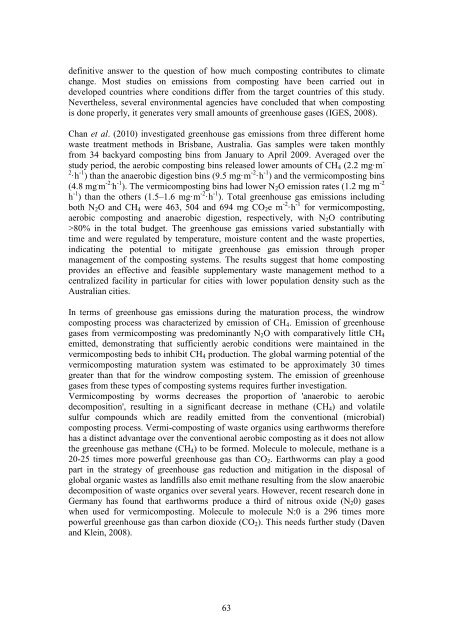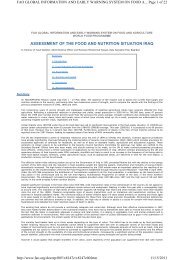Vermiculture in Egypt: - FAO - Regional Office for the Near East and
Vermiculture in Egypt: - FAO - Regional Office for the Near East and
Vermiculture in Egypt: - FAO - Regional Office for the Near East and
Create successful ePaper yourself
Turn your PDF publications into a flip-book with our unique Google optimized e-Paper software.
def<strong>in</strong>itive answer to <strong>the</strong> question of how much compost<strong>in</strong>g contributes to climate<br />
change. Most studies on emissions from compost<strong>in</strong>g have been carried out <strong>in</strong><br />
developed countries where conditions differ from <strong>the</strong> target countries of this study.<br />
Never<strong>the</strong>less, several environmental agencies have concluded that when compost<strong>in</strong>g<br />
is done properly, it generates very small amounts of greenhouse gases (IGES, 2008).<br />
Chan et al. (2010) <strong>in</strong>vestigated greenhouse gas emissions from three different home<br />
waste treatment methods <strong>in</strong> Brisbane, Australia. Gas samples were taken monthly<br />
from 34 backyard compost<strong>in</strong>g b<strong>in</strong>s from January to April 2009. Averaged over <strong>the</strong><br />
study period, <strong>the</strong> aerobic compost<strong>in</strong>g b<strong>in</strong>s released lower amounts of CH4 (2.2 mg·m -<br />
2 ·h -1 ) than <strong>the</strong> anaerobic digestion b<strong>in</strong>s (9.5 mg·m -2 ·h -1 ) <strong>and</strong> <strong>the</strong> vermicompost<strong>in</strong>g b<strong>in</strong>s<br />
(4.8 mg . m -2. h -1 ). The vermicompost<strong>in</strong>g b<strong>in</strong>s had lower N2O emission rates (1.2 mg m -2<br />
h -1 ) than <strong>the</strong> o<strong>the</strong>rs (1.5–1.6 mg·m -2 ·h -1 ). Total greenhouse gas emissions <strong>in</strong>clud<strong>in</strong>g<br />
both N2O <strong>and</strong> CH4 were 463, 504 <strong>and</strong> 694 mg CO2e m -2 ·h -1 <strong>for</strong> vermicompost<strong>in</strong>g,<br />
aerobic compost<strong>in</strong>g <strong>and</strong> anaerobic digestion, respectively, with N2O contribut<strong>in</strong>g<br />
>80% <strong>in</strong> <strong>the</strong> total budget. The greenhouse gas emissions varied substantially with<br />
time <strong>and</strong> were regulated by temperature, moisture content <strong>and</strong> <strong>the</strong> waste properties,<br />
<strong>in</strong>dicat<strong>in</strong>g <strong>the</strong> potential to mitigate greenhouse gas emission through proper<br />
management of <strong>the</strong> compost<strong>in</strong>g systems. The results suggest that home compost<strong>in</strong>g<br />
provides an effective <strong>and</strong> feasible supplementary waste management method to a<br />
centralized facility <strong>in</strong> particular <strong>for</strong> cities with lower population density such as <strong>the</strong><br />
Australian cities.<br />
In terms of greenhouse gas emissions dur<strong>in</strong>g <strong>the</strong> maturation process, <strong>the</strong> w<strong>in</strong>drow<br />
compost<strong>in</strong>g process was characterized by emission of CH4. Emission of greenhouse<br />
gases from vermicompost<strong>in</strong>g was predom<strong>in</strong>antly N2O with comparatively little CH4<br />
emitted, demonstrat<strong>in</strong>g that sufficiently aerobic conditions were ma<strong>in</strong>ta<strong>in</strong>ed <strong>in</strong> <strong>the</strong><br />
vermicompost<strong>in</strong>g beds to <strong>in</strong>hibit CH4 production. The global warm<strong>in</strong>g potential of <strong>the</strong><br />
vermicompost<strong>in</strong>g maturation system was estimated to be approximately 30 times<br />
greater than that <strong>for</strong> <strong>the</strong> w<strong>in</strong>drow compost<strong>in</strong>g system. The emission of greenhouse<br />
gases from <strong>the</strong>se types of compost<strong>in</strong>g systems requires fur<strong>the</strong>r <strong>in</strong>vestigation.<br />
Vermicompost<strong>in</strong>g by worms decreases <strong>the</strong> proportion of 'anaerobic to aerobic<br />
decomposition', result<strong>in</strong>g <strong>in</strong> a significant decrease <strong>in</strong> methane (CH4) <strong>and</strong> volatile<br />
sulfur compounds which are readily emitted from <strong>the</strong> conventional (microbial)<br />
compost<strong>in</strong>g process. Vermi-compost<strong>in</strong>g of waste organics us<strong>in</strong>g earthworms <strong>the</strong>re<strong>for</strong>e<br />
has a dist<strong>in</strong>ct advantage over <strong>the</strong> conventional aerobic compost<strong>in</strong>g as it does not allow<br />
<strong>the</strong> greenhouse gas methane (CH4) to be <strong>for</strong>med. Molecule to molecule, methane is a<br />
20-25 times more powerful greenhouse gas than CO2. Earthworms can play a good<br />
part <strong>in</strong> <strong>the</strong> strategy of greenhouse gas reduction <strong>and</strong> mitigation <strong>in</strong> <strong>the</strong> disposal of<br />
global organic wastes as l<strong>and</strong>fills also emit methane result<strong>in</strong>g from <strong>the</strong> slow anaerobic<br />
decomposition of waste organics over several years. However, recent research done <strong>in</strong><br />
Germany has found that earthworms produce a third of nitrous oxide (N20) gases<br />
when used <strong>for</strong> vermicompost<strong>in</strong>g. Molecule to molecule N:0 is a 296 times more<br />
powerful greenhouse gas than carbon dioxide (CO2). This needs fur<strong>the</strong>r study (Daven<br />
<strong>and</strong> Kle<strong>in</strong>, 2008).<br />
63





